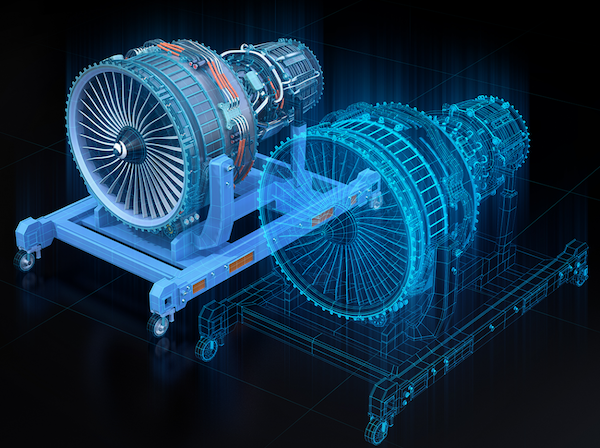Preparing for Multi-Metaverses with Multi-Twins
Anticipating the data management challenges with digital twins.

Simulation software maker Ansys offers Ansys Twin Builder, a technology stack to build and operate simulation-driven industrial digital twins. Image courtesy of Ansys.
Latest News
November 16, 2023
The Digital Twin Consortium, a member-supported industry group comprising private companies, government bodies and academic institutions, defines a digital twin as “a virtual representation of real-world entities and processes, synchronized at a specified frequency and fidelity.” What is key is that the digital twin is a live data connection, “synchronized at a specific frequency and fidelity.”.
“Often, people confuse a simulation model with a digital twin. What makes the model a digital twin is the two-way information flow from that physical asset to the twin,” says Prith Banerjee, chief technology officer, Ansys.
Synchronized with live data, the twin faithfully reflects the history and characteristics of the physical product, from its manufacturing defects to its accumulated wear and tear. A twin that fulfills this requirement could be the primary data source for the enterprise.
In the popular lingo of product lifecycle management (PLM), it could become “a single source of the truth.” Different stakeholders should be able to rely on it for the maintenance schedule, replacement part number, supplier info, structural simulation and other functions.
“While there are many elements that might make up the comprehensive digital twin—3D geometry, analysis models, simulations, requirements, manufacturing data, supplier information and so on—the comprehensive digital twin includes all of the information required to define your product, how the product will be produced and how it will function in use,” says Dale Tutt, vice president of Industry Strategy, Siemens Digital Industries Software.
Can this vision ever be realized in practice? Some experts point out that while possible, the data-management burden should not be underestimated.
A Single Model for Multiple Purposes
A CAD model represents how the engineer expects a product to be built. But the manufactured objects often include deviations and artifacts. Capturing the topology of as-built objects is crucial to digital twin creation. Many rely on 3D scanners for this purpose.
“It may not always be feasible to maintain a single model, especially when specific stakeholders’ needs require different levels of detail or information. One possible solution is to create a detailed master model that contains any information necessary, from which stakeholders can extract specific data as required,” says Gleb Gusev, co-founder and chief technology officer of scanner maker Artec 3D.
Artec 3D also offers Artec Studio software for professional 3D scanning and data processing, and Artec Cloud for browser-based 3D scan data management.
The volume of details required for simulation could vary depending on the type of physics involved and the desired accuracy. Also, the specific information needed for supply chain management, predictive maintenance and producing marketing content is not the same. Therefore, it’s possible that, for some, maintaining subsystems or purpose-built variations as twins may be unavoidable.
“If multiple digital twins are necessary, challenges likely include ensuring data consistency and managing the need for increased data storage. In addition, integrating new information into multiple models could be complex and time-consuming, leading to higher labor costs. These aspects need to be considered when deciding between the single model or multi-model approach,” says Gusev.
Potential Knots in the Digital Thread
Banerjee believes digital twins are part of the digital thread, a data continuum that spans across product lifecycles. He also acknowledges stitching together a robust digital thread means taking on a heavy data management burden. Take a typical aircraft engine manufacturer, for example.
“The most accurate digital twin is a model that reflects the asset’s current behavior and the entire history of its digital thread, because you want to make what-if predictions based on it. So for each engine, you must keep its historical data. The engines that have flown across New York, New Zealand, India and China are not the same as those that have flown across Africa. Clearly, data management will be an issue,” he says.
Banerjee is not suggesting manufacturers track every component of every unit in operation. Instead, he recommends digital twin operators identify what is mission-critical to limit the data-management workload. The need to prevent catastrophic midair engine failures alone easily justifies tracking the anomalies and service records related to every aircraft engine.
On the other hand, the cost-benefit ratio can hardly justify tracking every laptop or lawnmower sold with its own digital twin. In these cases, a representative digital twin—a twin that exhibits the characteristics of a specific product line or variant—may be the most pragmatic approach.
The Search for a Suitable Custodian
Suppose you want to build and maintain a digital twin of a plane, train, building or city. Where would that twin live? It’s a digital entity, so it would have to live in a digital environment. NVIDIA has been championing Omniverse, its interactive 3D platform, as the ideal home for industrial digital twins. It has already found a few tenants, so to speak.
Telecom firm Ericsson is using NVIDIA Omniverse to simulate, analyze and plan 5G deployment, by constructing digital versions of the cities targeted for deployment. In addition, BMW Group’s electric vehicle plant in Debrecen, Hungary, is scheduled to open in 2025, but a digital version has already been built in NVIDIA Omniverse.
“With the various planning systems consolidated within a digital twin, our teams around the world can now work together in real time and make decisions faster and on a more solid foundation,” says Milan Nedeljkovic, member of BW AG’s management board.
While NVIDIA’s Omniverse has seen adoption momentum, it’s by no means the only metaverse to house digital twins. Other tech giants like Facebook, Microsoft, Apple and Amazon are also potential providers, competing to be the landlords of your industrial digital twins. So most likely, we will have not one metaverse but various metaverses, housing industrial digital twins belonging to different manufacturers.

Siemens Digital Industries Software division offers software for building and simulating digital twins. The company has a partnership with NVIDIA to connect NVIDIA Omniverse and Siemens Xcelerator platforms for this purpose. Image courtesy of Siemens.
Banerjee expects almost all major cloud providers to compete for market share in digital twin custodianship. That means digital twin operators will likely face a dilemma in picking a platform.
It’s not an easy decision. It amounts to making a long-term investment in digital infrastructure for mission-critical items.
“Each company will have to make that decision,” says Banerjee.
The decision will most likely be influenced by existing relationships, the reputation and longevity of the platform provider, and the specific features that cater to the digital twin operator’s industry.
Ansys offers Ansys Twin Builder, a technology stack for creating and maintaining analytics-driven, simulation-based digital twins.
“You can build a digital twin based purely on data analytics, but our value proposition is, we can offer you simulation. You can collect temperature variations with time stamps, but if you need to understand why your product is heating up during certain parts of the day, we can give you the technology to simulate and analyze how and why it’s heating up,” explains Banerjee.
Quest for a Common Language
For its platform Omniverse, NVIDIA is betting on the Pixar-developed open-format USD Universal Scene Description (USD). In his keynote at SIGGRAPH 2023, NVIDIA CEO Jensen Huang said, “OpenUSD is a very big thing—a game changer.”
He describes it as “a framework, a universal interchange for creating 3D worlds, for describing, for compositing, for simulation, for collaborating on 3D projects.”
The company is also putting its clout behind the Alliance for OpenUSD (AOUSD), a steering group that includes Pixar, Autodesk, Adobe and Apple as founding members.
“Siemens supports USD in the Siemens Xcelerator platform and is collaborating with NVIDIA with the next version of the format,” says Tutt. “There are many methods of integrating the data within the digital twin across organizations and ecosystems.
For example, in Germany, Siemens is exploring how the Asset Administration Shell can be used to exchange data for machinery manufacturing.”
“We at Ansys are following the development of OpenUSD very carefully, to see if and when we should join,” Banerjee says.
Adds Gusev, “Given its impressive ability to encapsulate various types of data, as well as their relationships and properties, OpenUSD has strong potential as a future standard language for digital twins.”
But Gusev doesn’t think it can replace other formats like STL or OBJ, already entrenched in workflows like 3D printing and VR applications, respectively.
“Different applications often have varied requirements and data usage patterns, which are reflected in their internal data formats. In other words, although OpenUSD could become an interoperable data format, it may not necessarily replace proprietary formats optimized for specific use cases,” says Gusev.
Kenneth Wong is DE’s resident blogger and senior editor. Email him at de-editors@digitaleng.news or share your thoughts on this article at digitaleng.news/facebook.
More Ansys Coverage
More Artec 3D Coverage
More NVIDIA Coverage
More Siemens Digital Industries Software Coverage
Subscribe to our FREE magazine, FREE email newsletters or both!
Latest News
About the Author
Kenneth Wong is Digital Engineering’s resident blogger and senior editor. Email him at kennethwong@digitaleng.news or share your thoughts on this article at digitaleng.news/facebook.
Follow DE





